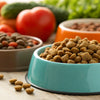Elevating Your Dog's Meal: What Can I Mix in My Dog's Kibble?
- Houndsy
Table of Contents
- Introduction
- Understanding the Basics of Dog Nutrition
- Why Mix in Additional Ingredients?
- Nutritious Mix-Ins for Your Dog's Kibble
- Tips for Mixing Ingredients
- Conclusion
Introduction
Did you know that over 40% of dog owners report their pets are picky eaters? If you’re one of them, you might be asking yourself: what can I mix in my dog's kibble to make their meals more enticing? As devoted pet parents, finding ways to enhance our furry friends' dining experience while ensuring they receive the necessary nutrients is a top priority.
At Houndsy, we understand the importance of a well-balanced diet for your dog’s health and happiness. Our mission has always been to simplify and elevate the dog-feeding experience, ensuring not only convenience but also aesthetics in your home. This blog post aims to explore various nutritious and delicious options you can mix into your dog’s kibble to boost their appetite, improve their health, and make mealtime a joyous occasion.
We'll cover a variety of mix-ins, including proteins, vegetables, and more, along with tips on how to incorporate them effectively. By the end of this article, you’ll have a clear understanding of how to diversify your dog’s diet and keep their meals exciting and nutritious.
Understanding the Basics of Dog Nutrition
Before we dive into the different mix-ins, it's essential to understand the foundation of dog nutrition. A balanced diet for dogs typically comprises proteins, carbohydrates, fats, vitamins, and minerals. Here’s a quick breakdown of each component:
- Proteins: Vital for growth, maintenance, and repair of tissues, proteins are a critical component of your dog’s diet. They help build muscles and support the immune system.
- Carbohydrates: These provide the energy your dog needs for daily activities. They also aid in digestion and promote gut health.
- Fats: Healthy fats are essential for a shiny coat and healthy skin. They also play a role in nutrient absorption.
- Vitamins and Minerals: These are crucial for various bodily functions, including bone health, immune function, and energy production.
Understanding these components allows us to make informed decisions on what to mix into our dog's kibble, ensuring we enhance their diet without compromising their health.
Why Mix in Additional Ingredients?
Mixing in extra ingredients can serve several purposes:
- Enhance Flavor: Dogs can get bored with the same flavor day in and day out. Adding variety can pique their interest and encourage them to eat.
- Nutritional Boost: Certain ingredients can provide additional vitamins and minerals that may not be present in kibble.
- Improve Texture: Mixing in wet or fresh foods can create a more appealing texture, especially for picky eaters.
- Healthy Treats: Add-ins can also serve as a way to reward your dog while enriching their diet.
Nutritious Mix-Ins for Your Dog's Kibble
Now that we understand the benefits of mixing in additional ingredients, let's explore some options that are both safe and healthy for your furry friend.
1. Lean Proteins
Adding lean proteins can significantly enhance your dog’s diet. Here are some great options:
- Cooked Chicken: Shredded or diced chicken is a favorite among dogs. It's lean, rich in protein, and easy to digest.
- Cooked Beef: Ground beef or small chunks can add flavor and protein to your dog’s meal. Be sure to choose lean cuts to avoid excess fat.
- Cooked Fish: Salmon or sardines (canned in water) are excellent sources of omega-3 fatty acids, promoting healthy skin and coat.
- Eggs: Cooked eggs are full of protein and essential nutrients. They can be scrambled or boiled and mixed in with kibble.
When mixing proteins, ensure they are cooked without any seasonings or additives that could be harmful to dogs.
2. Vegetables
Vegetables are a fantastic way to add fiber, vitamins, and minerals to your dog's diet. Here are some dog-friendly options:
- Carrots: Raw or cooked carrots are low in calories and high in fiber. They can also help with dental health.
- Green Beans: These are a low-calorie treat that provides fiber and vitamins. Cook and chop them before mixing.
- Sweet Potatoes: Cooked and mashed sweet potatoes offer a nutritious carbohydrate source, rich in vitamins A and C.
- Peas: Fresh or frozen peas can be a tasty addition, packed with protein and fiber.
3. Fruits
In moderation, fruits can be an excellent addition to your dog’s kibble. Here are some fruits that are safe for dogs:
- Apples: Sliced apples (without seeds) provide vitamins A and C. They also add a crunchy texture.
- Blueberries: These small berries are packed with antioxidants and can be mixed directly into kibble.
- Bananas: A great source of potassium and fiber, mashed banana can add sweetness to your dog’s meal.
- Pumpkin: Canned pumpkin (not the spiced pie filling) is a fantastic source of fiber and aids in digestion. Mix it in for a nutritional boost.
4. Dairy Options
Many dogs enjoy dairy, which can also offer nutritional benefits. Here are some safe dairy options:
- Plain Greek Yogurt: Rich in protein and probiotics, a spoonful of plain yogurt can support digestive health.
- Cottage Cheese: In moderation, cottage cheese is a good source of protein. Just be cautious if your dog is lactose intolerant.
- Cheese: Small amounts of cheese can be a tasty treat. Opt for low-fat varieties and avoid giving cheese daily to prevent weight gain.
5. Healthy Fats
Incorporating healthy fats into your dog's diet can promote a shiny coat and overall health:
- Olive Oil: A drizzle of olive oil can enhance flavor and provide essential fatty acids.
- Coconut Oil: This can be mixed into kibble for added energy and benefits for skin and coat health.
- Flaxseed Oil: A few drops can help boost omega-3 intake, which is great for skin and coat health.
6. Commercial Toppers
If you're short on time or looking for convenience, consider high-quality commercial dog food toppers. These are specifically designed to complement kibble and often come in various flavors and formats.
7. Broth
Adding a splash of low-sodium chicken or beef broth can make your dog’s meal more enticing. Just ensure it does not contain onion or garlic, which are toxic to dogs.
Tips for Mixing Ingredients
When incorporating these additional ingredients, keep the following tips in mind:
- Start Small: Introduce new ingredients gradually to avoid digestive upset. Start with small amounts and observe your dog's reaction.
- Balance is Key: Ensure that the majority of your dog's diet (around 90%) comes from a complete and balanced kibble. Use add-ins as a supplement rather than a replacement.
- Consult Your Vet: If your dog has specific dietary needs or health issues, consulting with a veterinarian before making significant changes to their diet is always a good idea.
- Monitor Weight: Be aware of your dog’s weight, as some additions might increase caloric intake. Adjust kibble portions accordingly if you add richer ingredients.
Conclusion
Mixing in nutritious ingredients can transform your dog’s mealtime into a delightful experience while ensuring they receive a well-rounded diet. From lean proteins to fresh fruits and vegetables, the options are plentiful. At Houndsy, we believe in enhancing the everyday experience of pet owners and their furry companions.
By incorporating these mix-ins into your dog’s kibble, you can not only elevate their diet but also ensure they look forward to mealtime.
For a convenient and stylish way to store and dispense your dog’s kibble, consider our Houndsy Kibble Dispenser. With its mid-century modern design and ergonomic convenience, it’s the perfect addition to simplify your dog-feeding experience. Check it out here.
FAQ
Q1: Can I mix raw food with kibble?
A1: Mixing raw food with kibble can be controversial. It’s essential to consult your veterinarian before making any significant dietary changes, particularly when it comes to raw diets.
Q2: How much of a mix-in should I add?
A2: Start with small amounts, around 10% of their total meal, and adjust based on your dog's preferences and health needs.
Q3: Are there any foods I should avoid mixing with kibble?
A3: Yes, avoid ingredients like chocolate, grapes, onions, garlic, and anything with xylitol, as these can be toxic to dogs.
Q4: Can I use leftovers from my meals as mix-ins?
A4: While some human foods are safe for dogs, it’s crucial to ensure they do not contain harmful seasonings or ingredients. Always check before serving.
Q5: What if my dog has allergies?
A5: If your dog has food allergies, it’s best to stick to hypoallergenic options and consult your vet for safe mix-ins.
By exploring these mix-in options, we can create a feeding ritual that is not only nourishing but also enjoyable for our dogs. Let’s make mealtime a highlight of their day!













